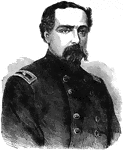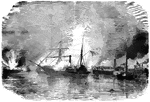Clipart tagged: ‘Vicksburg’

Cannon Dismounted
"Siege of Vicksburg- cannon dismounted inside the Confederate works."— Frank Leslie, 1896

Edward Ferrero
"General Edward Ferrero was born in Granada, Spain, January 18th, 1831. His parents were Italian, and…

Harriet Lane
"Daring and desperate attack- surprise and capture of the United States gunboat Harriet Lane…

William T. Sherman
William Tecumseh Sherman (February 8, 1820 – February 14, 1891) was an American soldier, businessman,…

Advance to Vicksburg
"Skirmishing in the woods, on the advance to Vicksburg. Our artist presents a most beautiful scene,…

Vicksurg, Mississippi
A view of Vicksburg, Mississippi which was first settled by the French, who built Fort-Saint-Pierre…

Siege of Vicksburg
"Siege of Vicksburg. Life in the trenches- bivouac of Leggett's Brigade- McPherson's Corps at the White…

Waterhouse's Battery
"Waterhouse's Battery, Sherman's Corps, before Vicksburg. The interior view of Waterhouse's battery,…
